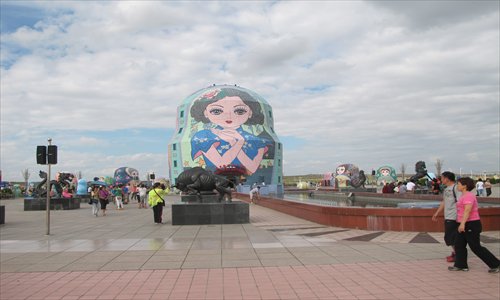
Matryoshka Square Photos: Xu Liuliu/GT
Thousands of years passed and the tradition lives on, but it's not as authentically presented for travelers from the outside world. The songs are still very powerful and pleasing to the ear, and the ceremony is the same as in older times. But wine, less prized than airag, is offered to tourists, and the mood soured when the unfinished portion was poured back into a pot for the next group.
Almost every one of these scenic spots is built near a lake. Hulun Buir Prairie gets its name from the nearby Hulun Lake and Buir Lake. Huhe Nur is another, smaller lake in the area. In Mongolian, Huhe Nur means cyan, referring to the blue color of its waters.
With the blue sky and white clouds above, and the breeze over the lake, it was a perfect moment to enjoy some food in a yurt with Mongolian songs and performances. Accompanied by traditional horse-head instruments, the performers sing songs from "Father's Prairie, Mother's Lake" to "Hulun Buir, Great Prairie."
Upon request, they will also perform Bokh, the exercise that every Mongolian man has practiced since childhood. Mongolian wrestling is perhaps better known through the name of the Naadam festival, which takes place every July. Bokh is the most important part of every Naadam festival. The two wrestlers, often wearing jodag, tight, collarless, short-sleeved jackets and gutal, traditional leather boots, enter the field, imitating the steps of eagles. The winner is announced when any part of his opponent's body above the knee touches the ground. If both fall, another round begins until one is the clear victor.
The view of Hulun Lake is breathtaking, as long as you can endure the bumpy three-hour ride to the site. Partly thanks to the bad road, the area around the lake is less developed, reserving its original flavor. Local families spend the weekends there, enjoying picnics and swimming.
A border town with Russian flair
When we got back to the city, I had a whole day to wander around. Manzhouli's downtown area is only a few blocks, making it feel more like a town. In addition to the Russian travelers you meet on every corner, the road signs and neon shop signs in Chinese, Mongolian and Russian remind tourists that they are in a border town of three countries. Due to the global economic recession, the number of Russian travelers and businessmen has decreased in recent years. If not for this, you might forget you are still in China.
The main city attractions include Matryoshka Square, the National Gate, the Russian Art Museum and the Wedding Palace. Matryoshka Square is a large square featuring Russian Matryoshka (nesting) dolls. Hundreds of dolls featuring various cultural flavors from Brazil to the Netherlands surround the main building, a 30-meter-tall Matryoshka doll. The doll, also the biggest in the world, has a theater and a restaurant inside. The fa?ade is painted with three girls, from China, Russia and Mongolia, on three panels. The Russian Art Museum, just next to the square, features reproductions of famous Russian paintings and sculptures.
Nightlife and food
Despite its small size, the city is rich in nightlife, and it seems to be a rule that every large restaurant and bar must have a stage. A performance was scheduled at 9pm at the Salt and Bread Russian Restaurant in my hotel. It is common to see Russian dances and hear Chinese and Mongolian songs while enjoying distinctly Russian dishes.
Local people favor Mongolian foods from shoubarou, hand-held meat, to hot pot. Locals are proud to say that they have the best lamb in the world because the sheep graze on the best grasses and drink spring water while being serenaded by Mongolian herdsmen.
Most restaurants serve hot pot and barbecue, especially roasted whole lamb. Russian food is also welcome here. But if you want to partake of the renowned all-fish feast, it is better to find a restaurant near Hulun Lake or Buir Lake.
Tips:
1. The best months to visit are June, July and August because of the extremely cold winter, which can reach minus 40 Celsius degree. Unless you aim to experience extreme cold, plan your trip for the summer.
2. If you like driving and have plenty of time, you can drive from Beijing and other large cities in the north. Otherwise, air travel is the most convenient. There are some car rental companies in the city that you can book ahead of the trip. After all, cars are essential to a visit to the grasslands.
3. The city mainly relies on tourism now because of the recession plaguing international trade. It is not difficult to find a hotel, but it can be a challenge to find a good one in August, the busiest month. It is best to use the Internet to book rooms in starred hotels like Shangri-La, the only five-star hotel in the city, before the trip.
4. It is still cool during the summer season in Manzhouli. Be sure to bring a coat and an umbrella, in case of sudden rain on the prairie.
5. Air-dried meat, and dairy products from milk tofu to candies are good gifts for friends. Matryoshka dolls that are found in every street shop are also a nice option for souvenirs.

Copyright ©1999-2011 Chinanews.com. All rights reserved.
Reproduction in whole or in part without permission is prohibited.